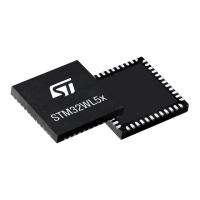Debug support (DBG) RM0453
1320/1454 RM0453 Rev 2
The two modes are mutually exclusive since they share the same I/O pins.
By default the JTAG-DP is selected after a system or a power-on reset. The five I/O pins are
configured by hardware in debug alternative function mode.
The SWJ-DP incorporates pull-up resistors on JTDI, JTMS/SWDIO and nJTRST, as well as
a pull-down resistor on JTCK/SWCLK.
A debugger can select the SW-DP by transmitting the following serial data sequence on
JTMS/SWDIO:
... (50 or more ones) ..., 0, 1, 1, 1, 1, 0, 0, 1, 1, 1, 1, 0, 0, 1, 1, 1, ... (50 or more ones) ...
JTCK/SWCLK must be cycled for each data bit.
In SW-DP mode, the unused JTAG pins JTDI, JTDO and nJTRST can be used for other
functions.
Note: All SWJ port I/Os can be reconfigured to other functions by software but debugging is no
longer possible.
38.3.8 JTAG debug port
The JTAG debug port (JTAG-DP) implements a TAP state machine (TAPSM) shown in
Figure 384, based on IEEE Std 1149.1-1990. The state machine controls two scan chains,
one associated with an instruction register (IR) and the other one with a number of data
registers (DR).

